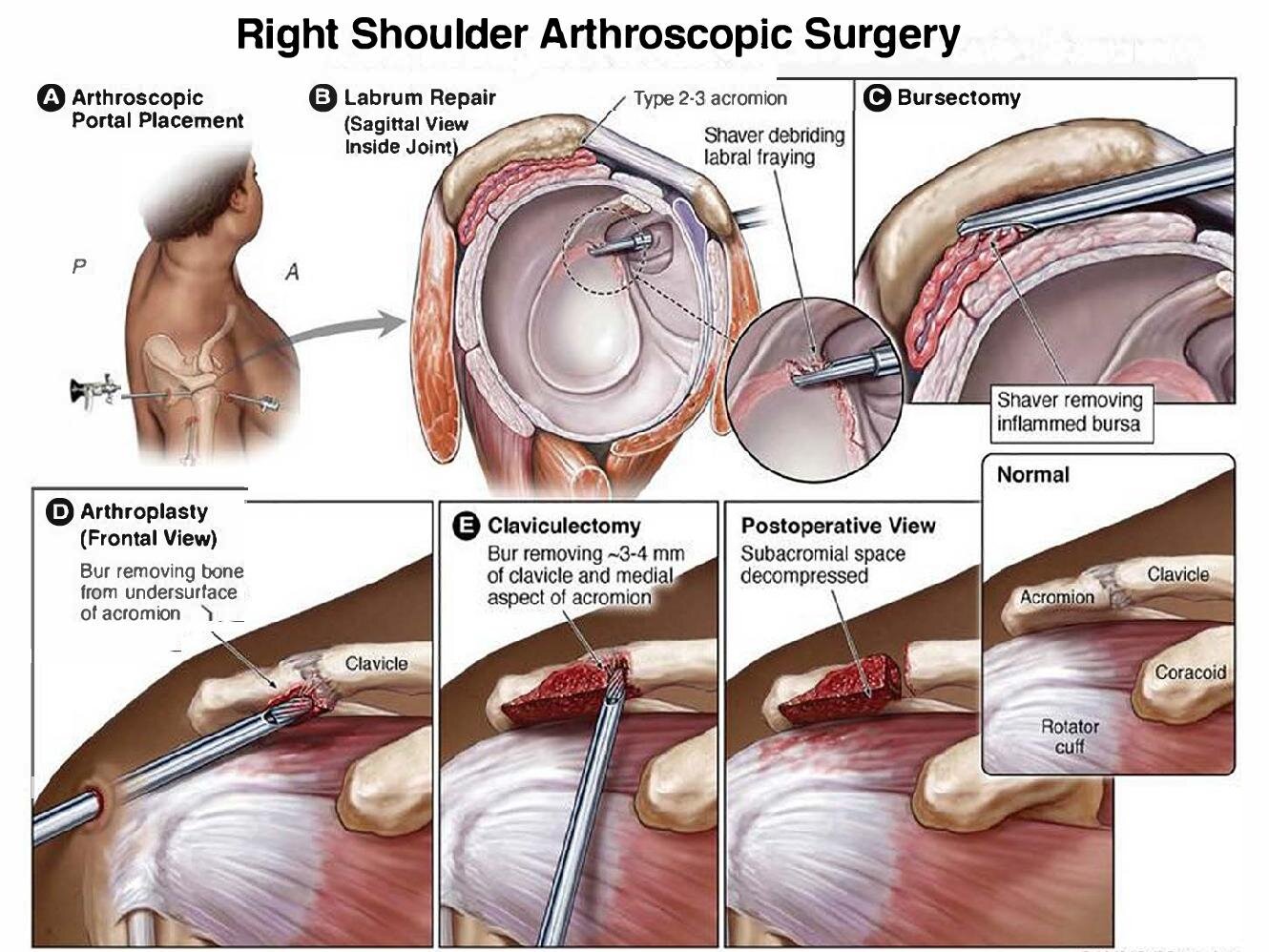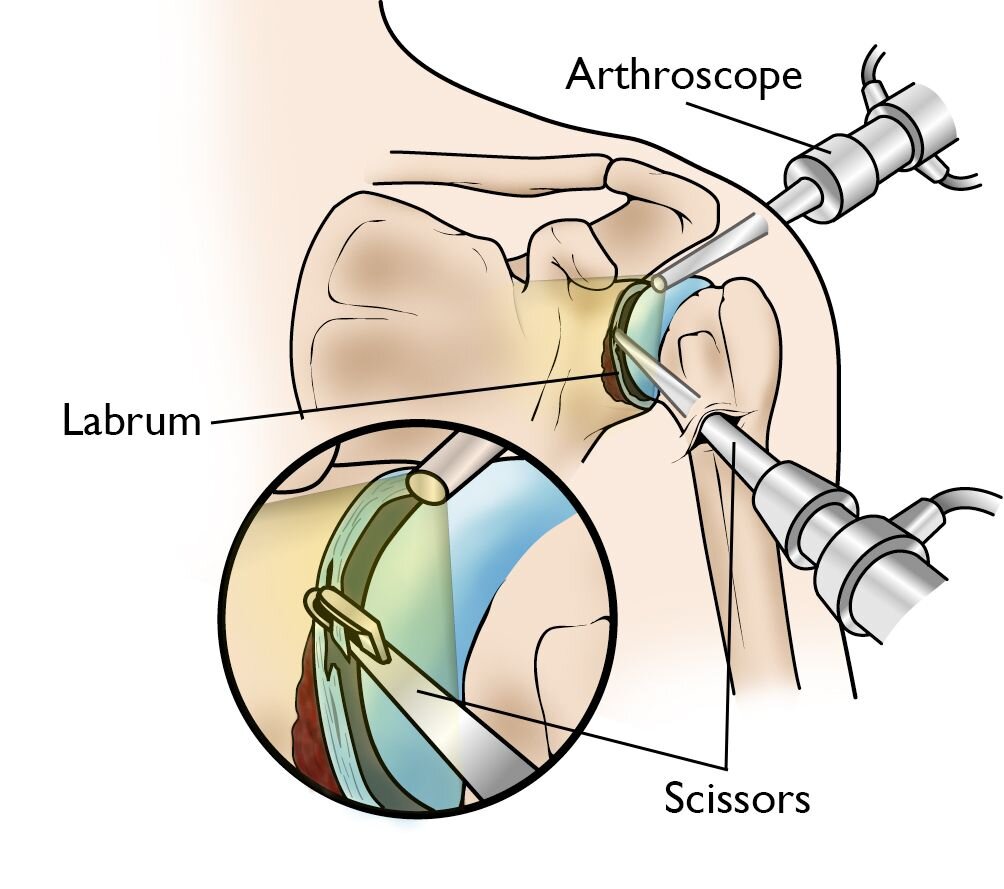Minimally Invasive Shoulder Surgery
Shoulder arthroscopy is surgery that uses a tiny camera called an arthroscope to examine or repair the tissues inside or around your shoulder joint. The arthroscope is inserted through a small cut (incision) in your skin.
At Aptiva Health, we offer same-day and walk-in appointments for shoulder injuries and conditions to evaluate, diagnose, and make the appropriate referral for additional treatment based upon your specific shoulder injury or condition. We treat spine injuries and conditions in our Sports Medicine, General Medicine, Orthopedics, and Physical Therapy departments.
Description
The rotator cuff is a group of muscles and their tendons that form a cuff over the shoulder joint. These muscles and tendons hold the arm in the shoulder joint. This also helps the shoulder move in different directions. The tendons in the rotator cuff can tear when they are overused or injured.
During a shoulder arthroscopy procedure, the surgeon:
Inserts the arthroscope into your shoulder through a small incision. The scope is connected to a video monitor in the operating room.
Inspects all the tissues of your shoulder joint and the area above the joint. These tissues include the cartilage, bones, tendons, and ligaments.
Repairs any damaged tissues. To do this, your surgeon makes 1 to 3 more small incisions and inserts other instruments through them. A tear in a muscle, tendon, or cartilage is fixed. Any damaged tissue is removed.
Types of Shoulder Arthroscopic Surgeries
all-arthroscopic rotator cuff repair
During arthroscopy, your surgeon inserts a small camera, called an arthroscope, into your shoulder joint. The camera displays pictures on a television screen, and your surgeon uses these images to guide miniature surgical instruments. During the arthroscopic rotator cuff repair, your surgeon can see the structures of your shoulder in great detail on a video monitor. Because the arthroscope and surgical instruments are thin, your surgeon can use very small incisions (cuts), rather than the larger incision needed for standard, open surgery. All-arthroscopic repair is usually an outpatient procedure and is the least invasive method to repair a torn rotator cuff.
(Left) The same rotator cuff tear, as seen from above the tendon.
(Right) The rotator cuff tendon has been re-attached to the greater tuberosity of the humeral head with sutures.
arthroscopic slap repair
A SLAP tear is an injury to the rim of cartilage that encircles the shoulder socket (known as the labrum). The term SLAP stands for "Superior Labrum Anterior and Posterior." A SLAP tear, therefore, occurs both in front (anterior) and back (posterior) of the labrum. This portion of the labrum is especially important as it serves as the attachment point of the biceps tendon.
Arthroscopic surgery may be used to restore the labrum back to its position at the rim of the shoulder socket. Once repositioned, sutures would secure the bone to the cartilage. If the damage extends into the biceps tendon, additional surgery may be needed.
Arthroscopic surgery may be used to restore the labrum back to its position at the rim of the shoulder socket. Once repositioned, sutures would secure the bone to the cartilage. If the damage extends into the biceps tendon, additional surgery may be needed.
Shoulder Arthroscopy for impingement syndrome
One of the most common reasons for shoulder surgery is the treatment of impingement syndrome. This is a condition in which the tendons of your rotator cuff are intermittently trapped and compressed during movement. This causes progressive damage to the tendons, as well as the cushions inside the joint space (called bursa).
Impingement syndrome can also be described as rotator cuff tendonitis and bursitis.
The arthroscopic procedure used to correct impingement is known as a subacromial decompression. The aim of the surgery is to increase the space between the rotator cuff and the top of the shoulder (known as the acromion).
arthroscopy for shoulder dislocation
A shoulder dislocation injury occurs when the ball of the shoulder joint comes out of the socket.
In young athletes, the damage most commonly occurs at the labrum. To stabilize the shoulder after dislocation, a type of surgery known as a Bankart repair can attach the labrum to the joint capsule to hold the ball in place.
Other cases involved generalized laxity of the shoulder ligaments which can lead to a condition known as multidirectional instability. This can cause the shoulder joint to come in and out of the socket very easily. Surgery would be used to tighten the joint capsule.
Repeated dislocations can lead to severe shoulder damage and require substantial surgery to keep the joint in place. While there are several different ways to achieve this, the procedures typically involve repositioning bone around the shoulder to hold the ball more securely in place.
arthrscopy for frozen shoulder (adhesive capsulitis)
Frozen shoulder is the second-most common cause of shoulder injury next to a rotator cuff tear. While the condition can usually be treated with non-surgical means, there are rare instances in which surgical treatment is required. When a frozen shoulder occurs, the capsule surrounding the shoulder joint becomes tight and contracted.
(Left) - Normal (Right) - Shoulder with Adhesive Capsulitis
The goal of surgery is to loosen the contracted tissue to allow the shoulder to move more freely. This is typically done by cutting the capsule all the way around the ball of the shoulder; this can be technically challenging given that the space inside the joint will be extremely tight.
Another challenge is that once the capsule is cut, the body will want to make new scar tissue. Aggressive physical therapy is essential to restoring the shoulder's full range of motion.
arthroscopic biceps tenodesis
Arthroscopic biceps tenodesis is indicated for the treatment of severe biceps tendonopathy, partial- or full-thickness tendon tears, or biceps instability typically associated with rotator cuff tear. Although there has been considerable debate on tenotomy versus tenodesis, our surgeons advocate tenodesis, for the following reasons: to re-establish the resting muscle length so as to avoid scaring and spasm, to allow biceps use for complex elbow motion, and to avoid cosmetic defects in cases in which deformity can sometimes equal disability.
Biceps tenodesis involves detaching the LHB from it's superior labrum in the shoulder and reattached to the humerus bone just below the shoulder. This procedure is more complex than a tenotomy, but avoids the risks of biceps discomfort, weakness and a 'popeye' appearance. Tenodesis is preferable for more active people. Using modern fixation screws the repair is strong enough to move the arm early after surgery.
Find our Shoulder Arthroscopic surgery post-operative instructions HERE


















